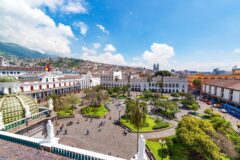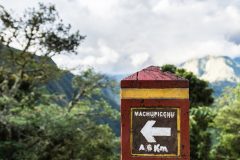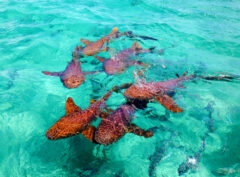One for the road

I am behind the wheel of a medium-sized automobile in a small, dusty town in Chile, looking for the Ruta del Vino through the Colchagua Valley.
There are few road markings. Signs, rather than telling you where the next town is, announce “Empanadas a 500m”. The tarmac is full of potholes. Pedestrians loiter, half about to cross the road, half inclined to continue chewing the fat with friends. An old man cycles by looking like the grim reaper, an enormous scythe balanced on his handlebars.
There are two cars ahead of us and then a lorry, which has about 100 sacks piled high on its roof. When it hits a pothole, it lurches violently to the left, the sacks seemingly about to go tumbling. “Watch out!” says my companion, Sara. “Stay back!”
I intend to. In these early moments of our South American road trip, I am a bit tense. It feels like driving without a seatbelt – not scary, but with a level of safety removed. I’m keeping an eye on stray dogs; on the alert for maniac drivers with fiery Latin temperaments; anticipating forbidding police officers. I am distracted by rows of copper pots for sale by the side of the road, blinding in the sunlight. Oh yes – it’s also baking. And it’s hard to stay cool when you’re hot. We haven’t worked out how the aircon works. I wind down my window, and an eager street-seller thrusts an empanada in my face.
And yet with one notable, blood-curdling exception, of which more later, this positioning of a parcel of stewed beef and onion under my nose is about as stressful as it gets over the next ten days. And had I known then how delicious an empanada de pino – pepped up with olive, raisin, boiled egg, cumin and paprika – could be, I’d not have wound my window back up with such haste.
We’re about 80 miles south of Santiago, perhaps a third of the way down Chile’s absurdly narrow spine, heading west towards the Pacific. The Andes, obscured by cloud, are behind us. There are 11 wineries along the 50km wine route which open their cellars to the public, including such supermarket stalwarts as Montes and Montgras. We visit three of them.
At Casa Silva, where we stay overnight in the beautiful, seven-bedroom hacienda, drunk on the scent of star jasmine clambering up its courtyard pillars, the highlight is a long lunch accompanied by half a dozen wines. Not far away polo horses are being put through their paces, and as the sauvignon blanc and the syrah and the carmenère go down, for a brief time we feel like South American aristocracy.
With its visitor centre perched on a ridge, the more family-oriented Santa Cruz vineyard offers glamorous vistas of vines sweeping across the bowl of the valley, and a cable car ride to a small observatory from where we view the Southern Cross, Jupiter and Canopus, the second-brightest star in the sky. Our favourite, though, is Viu Manent, where the tour is light on fermentation techniques and potent on drama – hopping out from our horse-drawn cart, we discover evidence of the earthquake that hit in 2010, crushing 12ft-high stainless-steel tanks “like cans of coca-cola”. Some of the survivors are impressively dented.
After a night in Santiago, where the Chilean passion for fried and grilled meat fills the air with the smell of smoking fat, we fly farther south to Temuco, gateway to the Lake District, in the centre of the country. It is cooler and greener here, and waiting for us in the drizzle at the small airport is a chunky red Nissan 4x4 flatbed truck. I’ve never driven anything like it before, and I wonder if it might not be a trifle de trop.
It’s raining when we arrive, and the surface of the lake, ten times the size of Windemere and ringed by black sand, is as dark and still as oil. The one and two-storey buildings and grid street plan remind me of North America, but there are two main differences. Hanging out on the corners of Pucón and the other towns are gangs of well-fed, healthy looking, aimiable dogs, always looking to go walkies with anyone who will tolerate being followed. The other difference is that Pucón has a snowcapped, 9,000ft volcano overshadowing it.
We want to join a walking tour to the crater, but we miss the 7am departure, and since we must be in Huife that night, we seem to have missed our chance. I am slightly crestfallen until it dawns on me: I have a 4WD pickup truck parked outside our hotel. We can drive up the volcano.
As we slither steadily upwards through thick forest along a narrow, gravelly, winding dirt road towards the summit, I’m pretty pleased simply to be driving a big red truck off-road. To be driving it up the side of a volcano to boot… Yes, this is what it’s all about, I think. And yes, this is where I have my blood-curdling moment.
When we reach the snowline, I ask Sara, who is Swedish and should know about these things, whether it’s OK to park in the snow. “Fine,” she says. Except that, after half an hour’s exploring the deserted ski-lift station, and congratulating ourselves on not having had to struggle on foot up the steep slopes disappearing into the cloud above us, it turns out not to be fine. Three times I try and fail to reverse out of the snow. My heart pounds. Are we going to be stuck up here?
A man wanders over and offers to push. I wave him away. My driving skills are going to extricate us from this mess. I try twice more without success. The man returns to my window, and starts pointing at something. I’ve left the handbrake on. As I wind down the window to thank him, the stink of burning rubber hits me like a slap in the face.
Heading south over the next several days, we swim by night in deserted hot springs; cruise the curvaceous shores of Lake Calafquén and Lake Panguipulli; drink zingy pisco sours and become addicted to tuna ceviche; discover thunderous waterfalls fed by rivers as green and clear as crème de menthe; stay in the six-storey Montaña Magica hotel in the Huilo Huilo forest reserve, made of wood, covered in plant life, and looking like a giant jellyfish.
One of the moments that will stay with me the longest, however, sees me behind the wheel of a rather large automobile, serene, relaxed, and suddenly aware that, although we passed through the toll booth a good three minutes ago, we haven’t yet seen another car on our side of the motorway. I put my foot down, watch the speed needle rise, and show our frisky red pickup truck who’s boss.
Tailor-made holidays
Flexible, custom-made holidays to Latin America created to match your exact requirements: our tailor-made itineraries are as unique as the clients for whom they are designed.
Design my tripPapagaio
Your edit for Latin American inspiration
Our exciting range of articles on Latin America explore everything from iconic destinations and lesser-known cultural gems to delicious traditional recipes. You’ll also find exclusive travel tips, first-hand client reviews and the chance to get your personal questions answered by our travel experts.
View Extraordinary Inspiration






































